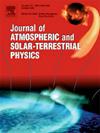Drought and flood evolution characteristics during winter rapeseed season based on the Z-index in Hubei Province, China
IF 1.9
4区 地球科学
Q3 GEOCHEMISTRY & GEOPHYSICS
Journal of Atmospheric and Solar-Terrestrial Physics
Pub Date : 2025-09-22
DOI:10.1016/j.jastp.2025.106646
引用次数: 0
Abstract
Analyzing drought and flood characteristics is of great significance to ensure production security, disaster prevention, and mitigation. Hubei Province, as a major rapeseed-producing area in China, is crucial for the nation's edible oil supply. However, there were no studies on drought and flood characteristics during rapeseed season in Hubei Province. To study the drought and flood evolution, daily meteorological data from 28 surface weather stations in Hubei Province during the rapeseed season from 1960 to 2019 was adopted to calculate the Z-index. The Mann-Kendall trend test and wavelet analysis were employed. The results indicated that precipitation at the seedling, flowering, ripening, and whole growth stages of rapeseed generally decreased by 4.79, 2.14, 2.58, and 7.38 mm (10 yr)−1, respectively. Precipitation at the budding stage of rapeseed increased by 1.74 mm (10 yr)−1. Based on the Mann-Kendall trend test, the mutation of precipitation at the seedling, budding, flowering, ripening, and whole growth stages of rapeseed began in 1987, 1983, 1961, 1960, and 1968, respectively. Precipitation at the seedling, ripening, and whole growth stages decreased from south to north across Hubei Province. From southeast to northwest of Hubei Province, precipitation at the budding and flowering stages decreased. A shift from drought to flood was observed at the budding stage, whereas a shift from flood to drought occurred at the other stages. Severe drought (15.0 %) and mild drought (20 %) occurred most frequently at the flowering stage. Severe flood occurred most often at the budding stage (16.7 %), moderate flood at the ripening stage (13.3 %), and mild flood at the seedling stage (13.3 %). According to the wavelet analysis, the cycles of drought and flood disasters at the seedling, budding, flowering, ripening, and whole growth stages were 28, 23, 14, 18, and 7 years, respectively. This study provides a scientific basis for predicting drought and flood disasters and guiding rapeseed production in Hubei Province.
基于z指数的湖北省冬季油菜籽季旱涝演变特征
分析旱涝特征对保障生产安全、防灾减灾具有重要意义。湖北省作为中国主要的油菜籽产区,对全国的食用油供应至关重要。但目前尚无对湖北省油菜季旱涝特征的研究。利用1960 - 2019年湖北省28个地面气象站的油菜籽季逐日气象资料,计算z指数,研究旱涝演变。采用Mann-Kendall趋势检验和小波分析。结果表明:油菜籽苗期、开花期、成熟期和全生育期降水总体上分别减少4.79、2.14、2.58和7.38 mm (10 yr)−1;油菜出芽期降水量增加1.74 mm (10 yr)−1。根据Mann-Kendall趋势检验,油菜苗期、出芽期、开花期、成熟期和全生育期降水分别在1987年、1983年、1961年、1960年和1968年发生突变。苗期、成熟期和全生育期降水量由南向北递减。湖北从东南向西北,出芽期和开花期降水呈减少趋势。出芽期由干旱向洪水转变,其他阶段由洪水向干旱转变。重度干旱(15.0%)和轻度干旱(20%)发生在花期。出芽期多发生重度洪水(16.7%),成熟期多发生中度洪水(13.3%),苗期多发生轻度洪水(13.3%)。根据小波分析,苗期、出芽期、花期、成熟期和全生育期的旱涝灾害周期分别为28年、23年、14年、18年和7年。该研究为预测湖北省旱涝灾害和指导油菜籽生产提供了科学依据。
本文章由计算机程序翻译,如有差异,请以英文原文为准。
求助全文
约1分钟内获得全文
求助全文
来源期刊

Journal of Atmospheric and Solar-Terrestrial Physics
地学-地球化学与地球物理
CiteScore
4.10
自引率
5.30%
发文量
95
审稿时长
6 months
期刊介绍:
The Journal of Atmospheric and Solar-Terrestrial Physics (JASTP) is an international journal concerned with the inter-disciplinary science of the Earth''s atmospheric and space environment, especially the highly varied and highly variable physical phenomena that occur in this natural laboratory and the processes that couple them.
The journal covers the physical processes operating in the troposphere, stratosphere, mesosphere, thermosphere, ionosphere, magnetosphere, the Sun, interplanetary medium, and heliosphere. Phenomena occurring in other "spheres", solar influences on climate, and supporting laboratory measurements are also considered. The journal deals especially with the coupling between the different regions.
Solar flares, coronal mass ejections, and other energetic events on the Sun create interesting and important perturbations in the near-Earth space environment. The physics of such "space weather" is central to the Journal of Atmospheric and Solar-Terrestrial Physics and the journal welcomes papers that lead in the direction of a predictive understanding of the coupled system. Regarding the upper atmosphere, the subjects of aeronomy, geomagnetism and geoelectricity, auroral phenomena, radio wave propagation, and plasma instabilities, are examples within the broad field of solar-terrestrial physics which emphasise the energy exchange between the solar wind, the magnetospheric and ionospheric plasmas, and the neutral gas. In the lower atmosphere, topics covered range from mesoscale to global scale dynamics, to atmospheric electricity, lightning and its effects, and to anthropogenic changes.
 求助内容:
求助内容: 应助结果提醒方式:
应助结果提醒方式:


